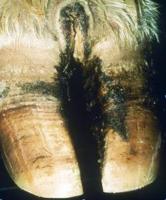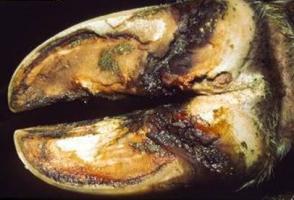Foot Rot in cattle and sheep / goats
Local names:
Luo: achany, abok / Borana & Gabbra: okol, bargao / Kipsigis: moeet / Gikuyu: rugumo / Maasai: Alelei, en jalan / Maragoli: bulwaye vwe tsimbagayu / Samburu: ngojini, namurie / Somali: raaf-dila, rafqarir, gumeed, rafdilnac, rafjac, bog, boog / Turkana: ekichodinu, ebaibai /
Common names: foul-in-the-foot, pietin, pietur (French), pedero (Spanish)
Introduction
Following periods of prolonged rain, outbreaks of foot rot appear in cattle, sheep and goats, even those kept under extensive production systems. Humid, warm conditions favour the organisms responsible. Foot rot can be a major disease problem under intensive dairy production systems, especially when zero-grazing is practised.
Other factors such as breed and housing are known to influence the occurrence and severity of the disease. Under intensive systems where exotic breeds are kept, the disease occurrence is more severe than in extensive systems where most indigenous breeds are normally kept.
The disease has negative economic consequences to the farmer because it hinders the animal from feeding at the time when there is plenty of good feed. Serious foot problems reduce the productive life-span of the dairy cow, which has to be culled too early.
|
|


